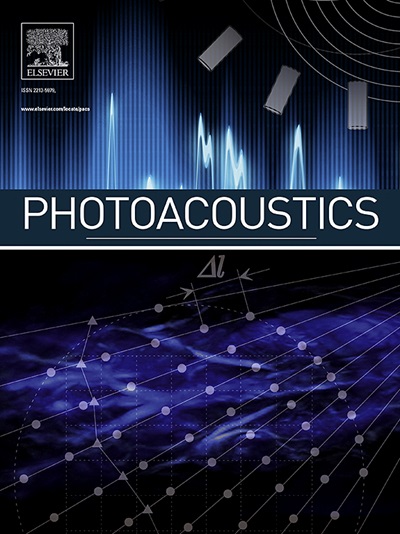Harnessing evanescent photoacoustic waves for multi-domain imaging
IF 7.1
1区 医学
Q1 ENGINEERING, BIOMEDICAL
引用次数: 0
Abstract
Photoacoustic microscopy (PAM) offers a non-invasive imaging method that overcomes the limitations of light scattering in biological tissues by visualizing optical contrast through the detection of photo-generated acoustic signals. While optical microscopy has significantly advanced through the exploration of optical evanescent waves, the potential of evanescent photoacoustic (PA) waves in PAM remains largely unexplored. In this work, we demonstrate the generation and detection of evanescent PA waves in PAM by positioning the sample near an interface, which directs these waves into the far-field beyond the supercritical angle (SA). These SA-PA signals exhibit distinct characteristics, including dependence of intensity on the source depths and symmetry in far-field angular patterns. Leveraging these features, we develop a proof-of-concept for supercritical angle photoacoustic microscopy (SA-PAM), which utilizes evanescent PA waves to enable new PAM functionalities, such as surface topography reconstruction and edge detection. This approach highlights the role of acoustic near-field exploration in advancing PA technology.
利用倏逝光声波进行多域成像
光声显微镜(PAM)提供了一种非侵入性成像方法,克服了光散射在生物组织中的局限性,通过检测光产生的声信号来实现视觉对比。虽然光学显微镜通过探索光学倏逝波已经取得了显着进步,但PAM中倏逝光声(PA)波的潜力仍然很大程度上未被探索。在这项工作中,我们演示了在PAM中产生和检测消失的PA波,方法是将样品定位在界面附近,该界面将这些波引导到远场,超过超临界角(SA)。这些SA-PA信号表现出明显的特征,包括强度依赖于源深度和远场角模式的对称性。利用这些特征,我们开发了一种超临界角光声显微镜(SA-PAM)的概念验证,它利用倏逝的PA波来实现新的PAM功能,如表面形貌重建和边缘检测。这种方法突出了声学近场探测在推进扩声技术中的作用。
本文章由计算机程序翻译,如有差异,请以英文原文为准。
求助全文
约1分钟内获得全文
求助全文
来源期刊

Photoacoustics
Physics and Astronomy-Atomic and Molecular Physics, and Optics
CiteScore
11.40
自引率
16.50%
发文量
96
审稿时长
53 days
期刊介绍:
The open access Photoacoustics journal (PACS) aims to publish original research and review contributions in the field of photoacoustics-optoacoustics-thermoacoustics. This field utilizes acoustical and ultrasonic phenomena excited by electromagnetic radiation for the detection, visualization, and characterization of various materials and biological tissues, including living organisms.
Recent advancements in laser technologies, ultrasound detection approaches, inverse theory, and fast reconstruction algorithms have greatly supported the rapid progress in this field. The unique contrast provided by molecular absorption in photoacoustic-optoacoustic-thermoacoustic methods has allowed for addressing unmet biological and medical needs such as pre-clinical research, clinical imaging of vasculature, tissue and disease physiology, drug efficacy, surgery guidance, and therapy monitoring.
Applications of this field encompass a wide range of medical imaging and sensing applications, including cancer, vascular diseases, brain neurophysiology, ophthalmology, and diabetes. Moreover, photoacoustics-optoacoustics-thermoacoustics is a multidisciplinary field, with contributions from chemistry and nanotechnology, where novel materials such as biodegradable nanoparticles, organic dyes, targeted agents, theranostic probes, and genetically expressed markers are being actively developed.
These advanced materials have significantly improved the signal-to-noise ratio and tissue contrast in photoacoustic methods.
 求助内容:
求助内容: 应助结果提醒方式:
应助结果提醒方式:


